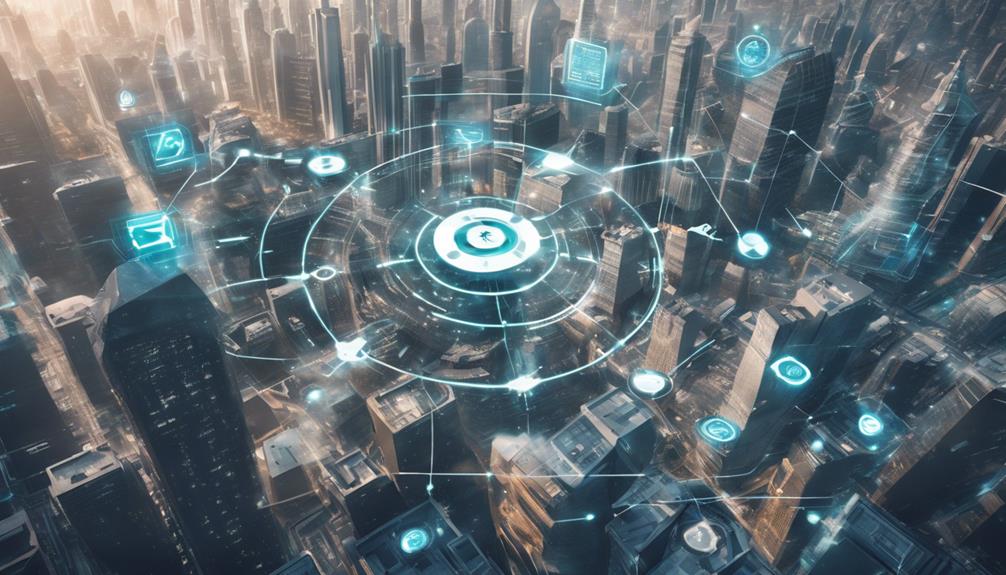AI profoundly impacts cybersecurity by enhancing threat detection, automating processes, and fortifying incident response. It revolutionizes prevention, detection, response, and recovery capabilities. Cybersecurity professionals anticipate a 95% improvement in security measures due to AI. However, challenges like data poisoning and susceptibility to attacks must be addressed with effective regulation and security measures. AI-driven anomaly detection aids in swift threat identification, while predictive analytics empower organizations to predict and prevent cyber threats. Proactive monitoring, automation, and collaboration between cybersecurity experts and AI developers play key roles in bolstering cyber defenses. Explore further to uncover the full spectrum of AI's influence on cybersecurity solutions.
Key Takeaways
- AI enhances threat detection accuracy and response time.
- Automation streamlines security operations and incident response.
- AI revolutionizes prevention, detection, and recovery capabilities.
- Improved defense mechanisms predict and prevent cyber threats.
- Data security measures become more proactive and efficient with AI.
AI's Role in Cyber Threat Detection
AI plays a pivotal role in enhancing cyber threat detection by leveraging advanced algorithms to analyze large volumes of data for identifying security vulnerabilities and potential risks. Through anomaly detection and threat intelligence, AI-powered tools like Darktrace's Self-Learning AI can effectively detect and mitigate unusual activities indicative of cyber threats.
By continuously monitoring patterns, behaviors, and network activities, AI contributes to the early identification of potential risks, enabling proactive measures to mitigate cyber risks in real-time. This proactive approach allows for the swift categorization of threats and the implementation of necessary security protocols to safeguard against evolving cyber threats.
Enhancing Cybersecurity Efficiency With AI
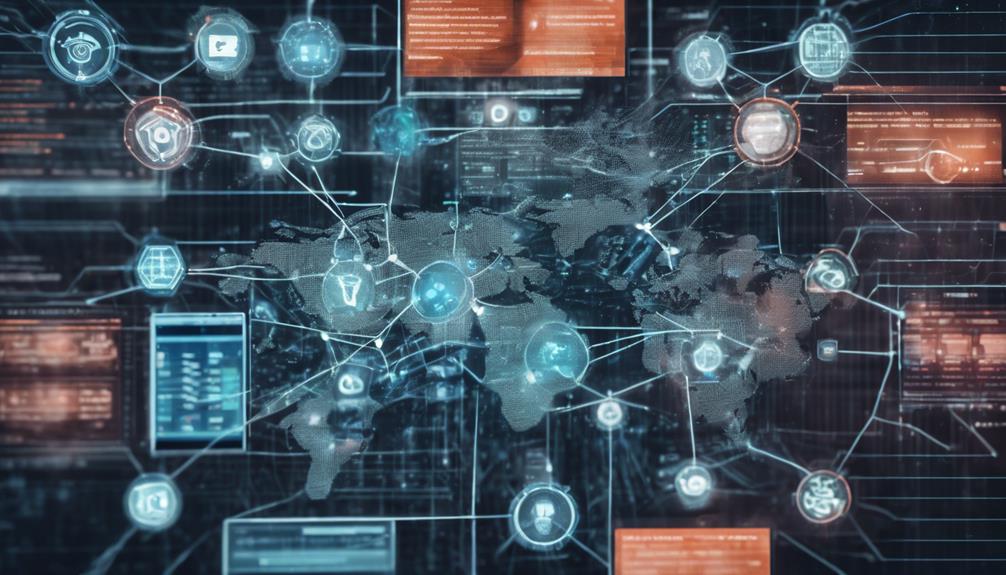
Enhancing efficiency in cybersecurity is paramount in the digital age, with advancements in artificial intelligence revolutionizing prevention, detection, response, and recovery capabilities. AI technology plays a pivotal role in fortifying security systems by expediting threat detection and response through automation and advanced algorithms. According to a survey, 95% of cybersecurity professionals anticipate AI to enhance defense and security measures greatly.
Utilizing AI in cybersecurity measures involves leveraging technologies like supervised machine learning, natural language processing (NLP), and unsupervised machine learning to bolster threat detection and automate security tasks. These AI-driven tools not only streamline processes but also enhance the accuracy and speed of identifying vulnerabilities and responding to incidents.
The table below illustrates the impact of AI in enhancing cybersecurity efficiency across different domains:
| Domain | Impact of AI in Cybersecurity |
|---|---|
| Cloud Security | Enhances cloud security measures through automated threat detection and response. |
| Data Security | Improves data protection by accelerating the identification of potential security breaches. |
| Network Security | Strengthens network defenses by automating security tasks and optimizing response mechanisms. |
| Incident Response | Speeds up incident response processes and enhances decision-making during security incidents. |
Challenges of AI in Cyber Defense
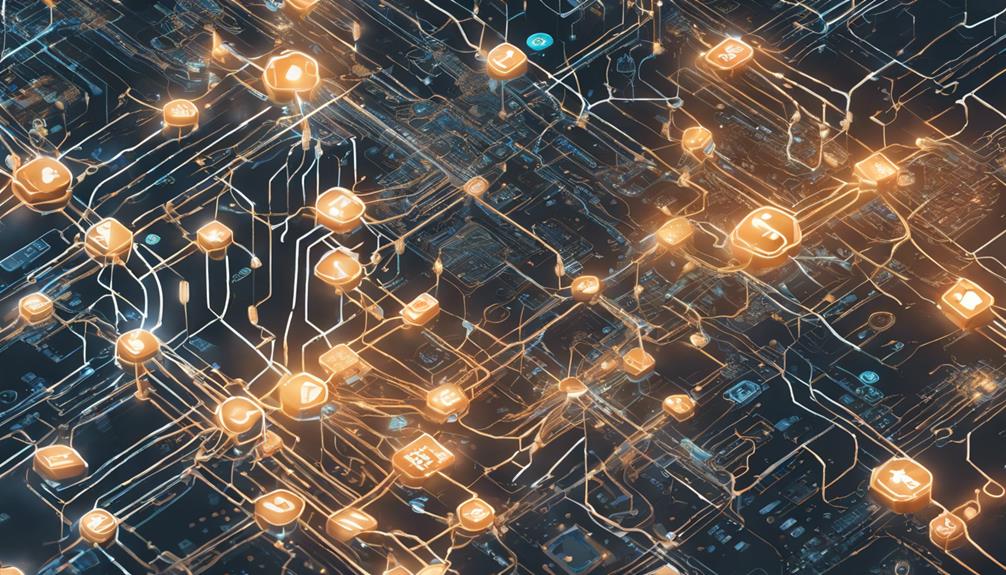
AI in cyber defense encounters various challenges, such as data poisoning, social engineering threats, and susceptibility to DoS attacks. These vulnerabilities can undermine the accuracy of threat detection systems and lead to the malicious exploitation of AI for cyber attacks.
It is imperative for organizations to address these issues through effective regulation, enhanced security measures, and continuous monitoring to safeguard against the misuse of AI in cybersecurity.
AI Defense Vulnerabilities
Cybersecurity professionals face significant challenges in defending against cyber threats due to vulnerabilities inherent in the utilization of artificial intelligence for defense purposes.
AI defense vulnerabilities expose systems to various cyberattacks, allowing threat actors to exploit weaknesses in AI algorithms, potentially bypassing security protocols.
Data poisoning presents a critical concern as it can manipulate AI learning processes, leading to inaccurate threat detection and response mechanisms.
Additionally, AI's ability to mimic human behavior poses risks by deceiving detection systems, emphasizing the urgent need for robust security measures.
Furthermore, the susceptibility of AI systems to Denial of Service (DoS) attacks underscores the importance of fortifying these systems against malicious exploitation.
As the cybersecurity landscape evolves, addressing these AI defense vulnerabilities becomes paramount to enhance the resilience of defense mechanisms against emerging threats.
Stay informed, vigilant, and proactive to safeguard against potential AI-related cyber risks.
Threat Detection Accuracy
The importance of threat detection in cyber defense presents challenges when utilizing artificial intelligence due to potential vulnerabilities in AI algorithms.
AI plays a crucial role in enhancing threat detection accuracy by analyzing vast amounts of data to identify anomalies and potential threats in cybersecurity. These AI-powered tools greatly improve the efficiency and effectiveness of threat detection processes, aiding in distinguishing normal activities from security risks for more precise threat identification.
Malicious AI Use
Malicious exploitation of artificial intelligence presents significant challenges in maintaining robust cyber defense mechanisms. Threat actors leverage malicious AI use to orchestrate targeted social engineering scams, manipulating individuals or organizations at reduced costs.
Additionally, the phenomenon of data poisoning can corrupt AI's learning algorithms, resulting in the creation of false images, videos, and audio for nefarious purposes. The susceptibility of AI systems to DoS attacks, which mimic human behavior, underscores the cybersecurity risks associated with AI technologies.
Such attacks can deceive threat detection capabilities by replicating human clicking patterns, emphasizing the importance of implementing stringent security measures against malicious AI use.
To counter these threats effectively, regulatory measures and enhanced threat detection capabilities are essential in mitigating the risks posed by malicious AI in cybersecurity, particularly in safeguarding data center activities.
Stay informed and vigilant to protect against evolving cyber threats driven by malicious AI applications.
Securing AI Systems From Threats
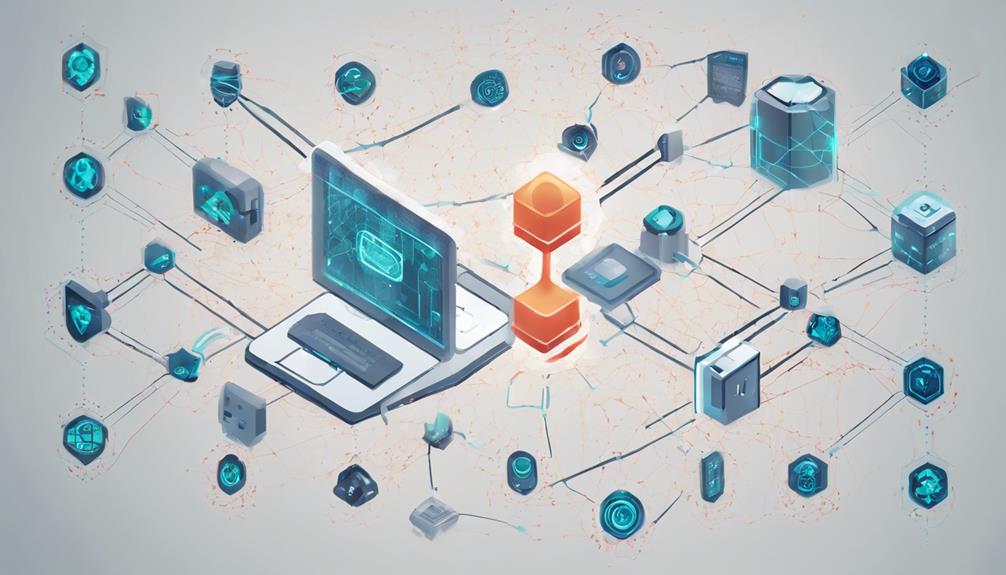
Ensuring the resilience of AI systems against potential threats is a critical priority in safeguarding sensitive data and maintaining operational integrity in the digital landscape. AI systems, with their complexity and value, can be sophisticated targets for cyber threats, making security and data protection essential.
One potential security risk lies in the poisoning of AI's data sets, which can compromise the learning process and lead to false outcomes. To secure AI systems from such threats, it is essential to protect them from malicious manipulation and hacking, thereby upholding system integrity.
Balancing innovation with integrity is key in the ethical development and utilization of AI systems in cybersecurity. By prioritizing the safety and strength of AI systems, organizations can mitigate vulnerabilities and enhance overall security measures.
Proactive measures, such as regular security audits, robust encryption protocols, and continuous monitoring, are crucial to fortifying AI systems against evolving threats in the digital landscape.
Impact of AI on Cybersecurity Solutions
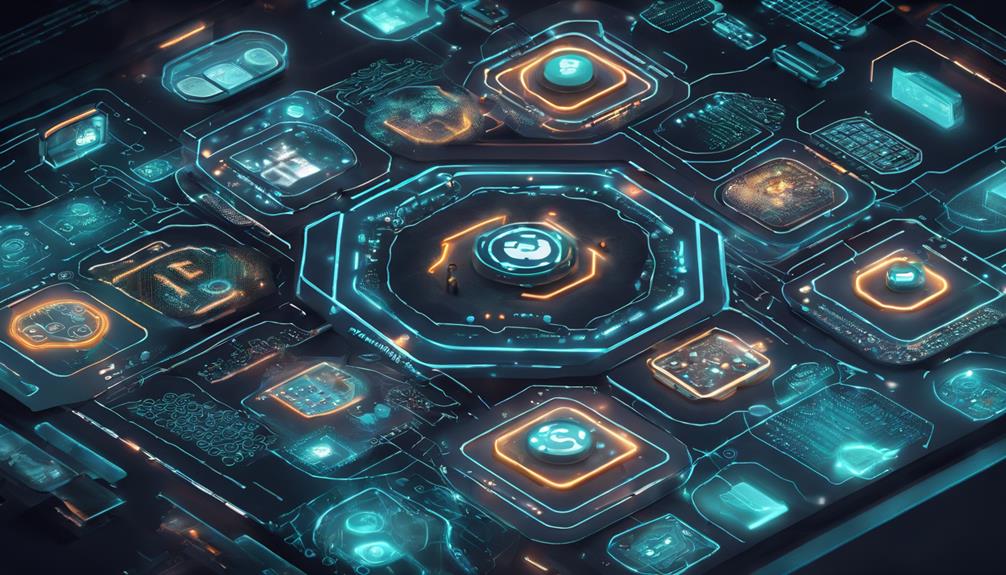
AI is reshaping cybersecurity solutions by bolstering threat detection capabilities and streamlining incident response processes.
With technologies like supervised machine learning and NLP at the forefront, AI is automating security tasks and accelerating the identification of vulnerabilities.
This transformation is revolutionizing how organizations defend against cyber threats, enhancing security measures across cloud, data, and network domains.
AI Enhancing Threat Detection
Advanced technologies powered by artificial intelligence have revolutionized threat detection capabilities in the field of cybersecurity solutions. AI capabilities, such as supervised machine learning and natural language processing, have greatly enhanced defensive AI, improving network security and incident response. Organizations are increasingly leveraging AI to accelerate threat detection and automate security tasks, ultimately strengthening their cybersecurity posture. According to Darktrace's survey of 1,800 professionals, 95% believe that AI-powered cybersecurity technologies will have a significant impact on defense mechanisms.
To highlight the impact of AI on threat detection, consider the following table showcasing the key benefits:
| Key Benefits | Description |
|---|---|
| Accelerated Threat Detection | AI speeds up the identification of potential threats, enabling swift responses. |
| Enhanced Incident Response | AI automates security tasks, improving the efficiency of incident response processes. |
| Improved Network Security | Defensive AI plays an important role in fortifying network security against emerging threats. |
| Strengthened Defensive AI | Organizations can benefit from enhanced cloud and data security through AI-driven solutions. |
AI Streamlining Incident Response
The optimization of incident response processes through artificial intelligence has greatly transformed the landscape of cybersecurity solutions. AI plays a pivotal role in streamlining incident response by identifying and prioritizing threats in real-time, slashing response times and minimizing breach impact.
Leveraging AI technologies like supervised machine learning and NLP enhances efficiency by automating threat detection and response processes, enabling organizations to bolster their cybersecurity posture. Darktrace's Self-Learning AI is a prime example, elevating incident response capabilities by correlating attack activities and offering a thorough view for effective remediation.
AI-powered anomaly detection further aids in swift threat identification and mitigation, empowering organizations to proactively address security incidents. The integration of AI in incident response not only expedites response actions but also facilitates the development of more effective threat mitigation strategies, ultimately fortifying cybersecurity defenses in today's dynamic threat landscape.
AI Integration in Security Operations
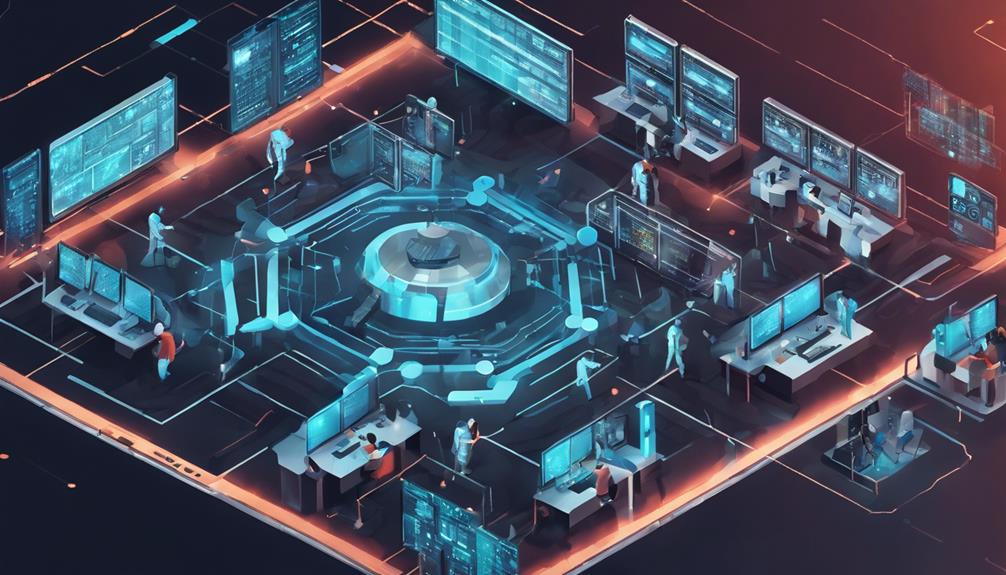
Integration of artificial intelligence in security operations enhances organizations' ability to detect and respond to cyber threats in real-time by analyzing vast amounts of data for anomalies. Implementing AI solutions in security systems brings several benefits:
- Improved Threat Detection:
AI aids in accurately identifying and mitigating cyber threats, enabling organizations to proactively defend against evolving attack methods.
- Enhanced Efficiency:
Automation of tasks such as vulnerability management and incident response streamlines security operations, increasing overall efficiency.
- Investment and Management:
Effective AI systems require significant initial investment and ongoing management to guarantee peak performance in detecting and responding to security incidents.
- Robust Data Sets:
Successful integration of AI in security operations hinges on the availability of thorough and high-quality data sets for analysis.
- Regulatory Alignment:
Aligning AI security solutions with privacy regulations like GDPR is essential to ensure compliance and protect sensitive information effectively.
Future of Cybersecurity With AI

Artificial intelligence's impact on the future of cybersecurity is poised to revolutionize threat detection and response capabilities. AI can help organizations stay ahead in the ever-evolving threat landscape by predicting and preventing cyber threats before they materialize.
By using AI, data security measures can become more robust, proactive, and efficient. The integration of AI in cybersecurity solutions will enable automated defense mechanisms that continuously learn and adapt to counter emerging cyber threats effectively.
Experts predict that AI advancements will empower organizations to combat cyber threats with greater precision and speed. This proactive approach to cybersecurity, driven by AI, will fundamentally transform how businesses safeguard their digital assets.
Embracing AI in cybersecurity strategies promises a future where organizations are better equipped to defend against sophisticated cyberattacks, ensuring a more secure online environment for all.
AI's Influence on Fraud Detection

AI's prowess extends beyond cybersecurity, making a significant impact on fraud detection through its ability to analyze data patterns and anomalies swiftly and effectively.
- AI enhances fraud detection by analyzing vast amounts of data to identify patterns and anomalies indicative of fraudulent activities.
- Machine learning algorithms in AI can detect unusual behaviors, transactions, or patterns that may signify fraud in real time.
- AI-powered fraud detection systems can adapt and evolve to new types of fraud schemes, improving accuracy and efficiency over time.
- AI can help financial institutions and businesses combat fraud by providing predictive analytics and early warning systems for potential fraudulent activities.
- The integration of AI in fraud detection reduces manual effort, speeds up detection, and minimizes false positives, enhancing overall cybersecurity measures.
AI's ability to sift through massive datasets and pinpoint suspicious activities in real-time revolutionizes fraud detection, empowering organizations to stay ahead of evolving threats efficiently and effectively.
Proactive Cyber Defense With AI

In the field of cybersecurity, AI plays a pivotal role in bolstering defenses against evolving threats. By harnessing AI for threat detection, organizations can proactively monitor network activities, identifying potential risks before they escalate.
Additionally, AI's integration into incident response strategies empowers swift and efficient mitigation of cyber attacks, fortifying overall security measures.
AI for Threat Detection
Utilizing advanced artificial intelligence technology, organizations can bolster their cybersecurity defenses through proactive threat detection methods. AI plays a vital role in enhancing threat detection capabilities and strengthening overall cybersecurity posture.
Here are some key ways AI contributes to threat detection in cybersecurity:
- AI analyzes vast amounts of data to identify anomalies and potential cyber threats, enabling organizations to stay vigilant.
- AI continuously monitors and analyzes network activities for any suspicious behavior, allowing for early detection of potential threats.
- AI-powered threat detection systems can detect and respond to cyber threats in real-time, improving the organization's ability to defend against attacks.
- AI automates threat detection processes, enabling swift and effective responses to emerging cyber threats without delays.
- AI's proactive approach to threat detection helps organizations stay ahead of cyber threats, reducing the risk of security breaches and ensuring a more secure digital environment.
AI in Incident Response
With its advanced capabilities, artificial intelligence enhances incident response by providing proactive cyber defense measures. AI in incident response enables organizations to continuously monitor network activities for anomalies, automating threat detection, response, and remediation processes to minimize the impact of cyberattacks.
By utilizing machine learning algorithms, AI-powered incident response systems can analyze patterns and behaviors in real-time, greatly reducing response times. These systems play an essential role in strengthening an organization's cybersecurity posture by detecting and mitigating threats before they escalate.
Addressing AI Cybersecurity Risks

Addressing the risks associated with AI in cybersecurity necessitates a holistic approach that integrates robust security measures and proactive threat detection strategies.
To effectively manage these challenges, consider the following key points:
- Implement AI-driven security solutions to counter evolving cyber threats efficiently.
- Regularly update and enhance AI algorithms to mitigate vulnerabilities and prevent data poisoning.
- Establish strict access controls and authentication measures to safeguard AI systems from unauthorized use.
- Incorporate anomaly detection techniques to identify and respond to unusual AI behaviors indicative of potential malicious activity.
- Enhance collaboration between cybersecurity experts and AI developers to address emerging risks and ensure thorough protection measures.
Frequently Asked Questions
How Is AI Impacting Cybersecurity?
AI is revolutionizing cybersecurity by enhancing threat detection, response, and recovery efficiency. Through supervised machine learning and NLP, AI accelerates threat identification and automates security tasks, strengthening defense mechanisms and improving incident response across security domains.
Will AI Affect Cybersecurity Jobs?
AI will greatly impact cybersecurity jobs by creating new roles, automating routine tasks, and necessitating AI skills. Cybersecurity professionals must upskill in AI technologies to handle sophisticated threats and enhance security postures effectively.
What Is the Role of AI in Enhancing Cyber Security?
In bolstering cybersecurity measures, AI serves as an invaluable asset, enhancing threat detection, response, and recovery processes. Its application, including advanced machine learning and NLP, greatly elevates defense capabilities, fostering a more secure digital landscape.
What Is the Negative Impact of AI in Security?
The negative impact of AI in security can include increased vulnerability to sophisticated cyberattacks targeting AI systems, high upfront costs for implementation, reliance on quality data, complex integration processes, resource-intensive management, and privacy concerns necessitating adherence to regulations.
Conclusion
In summary, the integration of AI in cybersecurity brings both opportunities and challenges. By enhancing threat detection, improving efficiency, and enabling proactive defense, AI offers a promising future for cybersecurity.
However, it is essential to address the risks associated with AI systems and guarantee their security. With careful consideration and proactive measures, AI can revolutionize cybersecurity solutions and strengthen defenses against cyber threats.
Embracing AI's potential while being mindful of potential vulnerabilities will be key in shaping the future of cybersecurity.
